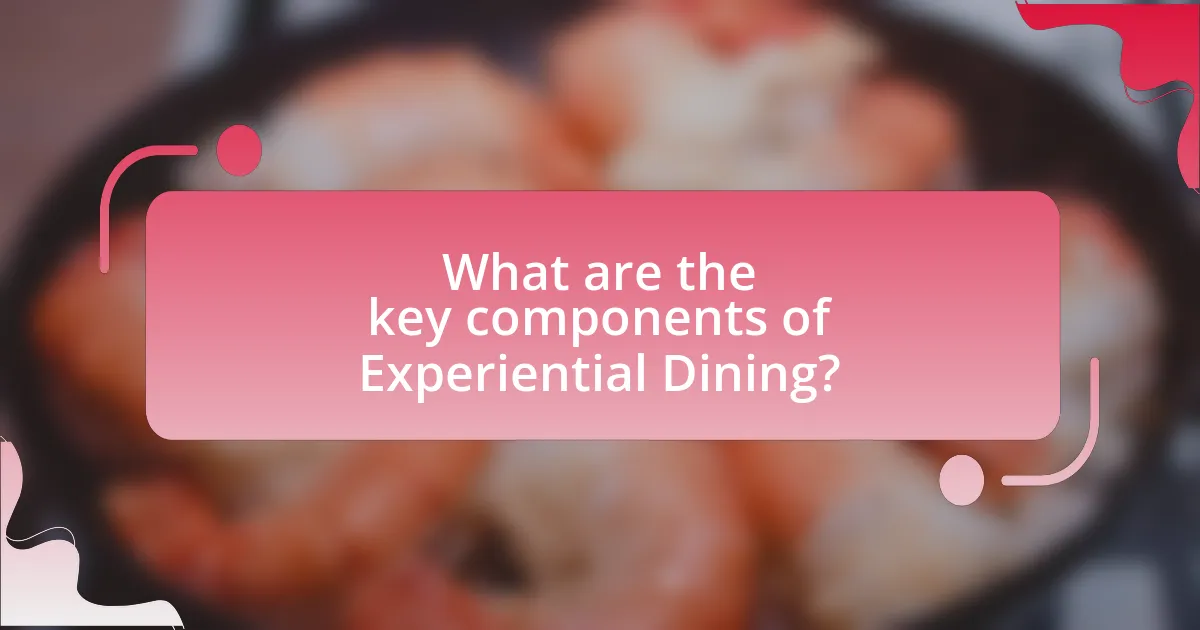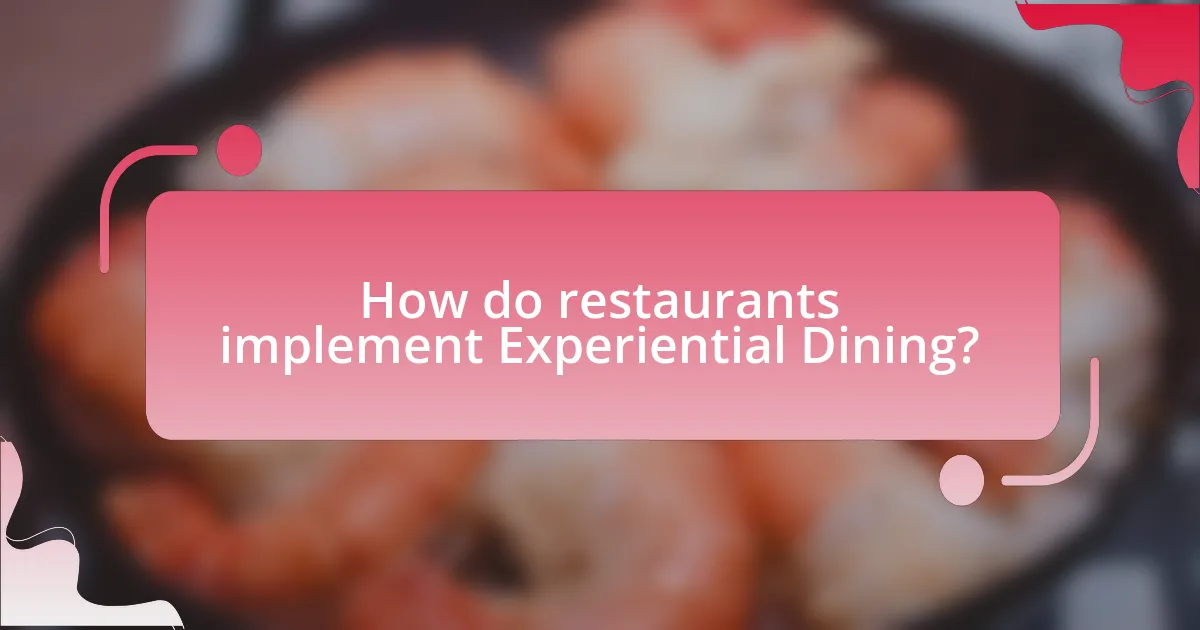Experiential dining is a culinary approach that prioritizes creating immersive and memorable experiences for diners, integrating themed environments, interactive service, and multi-sensory engagement. This article explores how experiential dining differs from traditional dining, highlighting key elements such as ambiance, personalized service, and storytelling that enhance customer satisfaction. It also examines the growing popularity of this trend, driven by consumer demand for unique experiences and the influence of social media. Additionally, the article addresses the challenges restaurants face in implementing experiential dining, including cost management and maintaining consistency, while offering best practices for successful execution.

What is Experiential Dining?
Experiential dining is a culinary approach that emphasizes creating memorable and immersive experiences for diners beyond just the food. This concept integrates elements such as themed environments, interactive service, and multi-sensory engagement to enhance the overall dining experience. Research indicates that restaurants employing experiential dining strategies can increase customer satisfaction and loyalty, as these unique experiences often lead to positive emotional connections with the brand.
How does Experiential Dining differ from traditional dining?
Experiential dining differs from traditional dining primarily in its focus on creating immersive and interactive experiences for guests rather than just serving food. In experiential dining, the atmosphere, presentation, and engagement with the diners are designed to evoke emotions and create memorable moments, often incorporating elements like themed environments, live performances, or interactive cooking. This approach contrasts with traditional dining, where the emphasis is mainly on the food quality and service without additional experiential elements. For example, restaurants like Dinner in the Sky offer unique dining experiences suspended in the air, showcasing how experiential dining can transform a meal into an event, thereby enhancing customer engagement and satisfaction.
What elements define the concept of Experiential Dining?
Experiential dining is defined by elements such as immersive environments, interactive food preparation, personalized service, and thematic storytelling. Immersive environments engage diners through unique decor and ambiance that enhance the overall experience. Interactive food preparation allows guests to participate in the cooking process, fostering a connection to the meal. Personalized service tailors the dining experience to individual preferences, creating a sense of exclusivity. Thematic storytelling integrates narratives into the dining experience, making meals memorable and engaging. These elements collectively contribute to a dining experience that goes beyond mere consumption, transforming it into an event that resonates with guests on multiple levels.
How do sensory experiences play a role in Experiential Dining?
Sensory experiences are fundamental to experiential dining as they engage multiple senses to enhance the overall dining experience. Restaurants utilize visual elements, such as plating and ambiance, to create an inviting atmosphere that stimulates sight. Additionally, aromas from food and beverages play a crucial role in evoking emotions and memories, which can influence taste perception. For instance, research indicates that the scent of food can enhance flavor perception by up to 90%. Furthermore, tactile sensations, such as the texture of food and the comfort of seating, contribute to the overall enjoyment and satisfaction of diners. By integrating these sensory elements, restaurants can create memorable experiences that resonate with customers, leading to increased loyalty and positive word-of-mouth.
Why is Experiential Dining gaining popularity?
Experiential dining is gaining popularity because it offers customers unique, immersive experiences that go beyond traditional eating. This trend is driven by consumers’ desire for memorable moments and social media shareability, with 70% of millennials preferring experiences over material goods, according to a study by Eventbrite. Restaurants are responding by creating themed environments, interactive meals, and chef-led events, which enhance customer engagement and satisfaction.
What trends are driving the rise of Experiential Dining?
The rise of Experiential Dining is driven by trends such as the demand for unique and immersive experiences, the influence of social media, and a focus on personalization. Consumers increasingly seek dining experiences that go beyond traditional meals, favoring restaurants that offer interactive elements, themed environments, and storytelling. Social media platforms amplify this trend, as visually appealing and unique dining experiences are shared widely, encouraging restaurants to innovate. Additionally, personalization in service and menu offerings caters to individual preferences, enhancing customer satisfaction and loyalty. These trends collectively contribute to the growing popularity of Experiential Dining.
How does social media influence the popularity of Experiential Dining?
Social media significantly enhances the popularity of experiential dining by providing a platform for sharing visually appealing content and unique dining experiences. Restaurants leverage social media to showcase their innovative dishes, themed events, and immersive atmospheres, which attract potential customers. For instance, a study by the Journal of Hospitality and Tourism Technology found that 70% of consumers are influenced by social media when choosing dining options, highlighting the impact of online visibility. Additionally, user-generated content, such as photos and reviews, creates a sense of authenticity and community, further driving interest and engagement in experiential dining.

What are the key components of Experiential Dining?
The key components of experiential dining include immersive environments, interactive elements, personalized service, and unique culinary presentations. Immersive environments create a thematic atmosphere that enhances the dining experience, often incorporating decor, lighting, and music that align with a specific concept. Interactive elements engage diners through activities such as cooking demonstrations or chef interactions, fostering a connection between guests and the culinary process. Personalized service tailors the dining experience to individual preferences, ensuring that guests feel valued and catered to. Unique culinary presentations, such as artistic plating or unexpected flavor combinations, elevate the meal and create memorable moments. These components collectively contribute to a dining experience that goes beyond traditional eating, making it memorable and engaging for customers.
How do ambiance and decor contribute to the dining experience?
Ambiance and decor significantly enhance the dining experience by influencing customers’ emotions and perceptions. A well-designed ambiance can create a welcoming atmosphere, making diners feel comfortable and relaxed, which is essential for enjoying a meal. For instance, studies show that lighting, color schemes, and music can affect mood and appetite; dim lighting often encourages intimacy, while bright colors can stimulate energy and conversation. Furthermore, decor elements such as artwork and furniture style can reflect the restaurant’s theme, reinforcing the overall dining concept and making the experience memorable. Research indicates that restaurants with cohesive and appealing decor can increase customer satisfaction and encourage repeat visits, as patrons associate the environment with positive dining experiences.
What role does lighting play in creating an immersive atmosphere?
Lighting plays a crucial role in creating an immersive atmosphere by influencing mood, perception, and engagement within a dining space. The intensity, color, and direction of light can evoke specific emotions and enhance the overall dining experience. For instance, warm lighting can create a cozy and intimate environment, while brighter, cooler lighting may energize and stimulate conversation. Research indicates that restaurants utilizing dynamic lighting designs can increase customer satisfaction and prolong dining duration, as evidenced by a study published in the Journal of Environmental Psychology, which found that ambient lighting significantly affects patrons’ emotional responses and their overall enjoyment of the meal.
How can themed decor enhance customer engagement?
Themed decor enhances customer engagement by creating an immersive environment that resonates with the target audience’s interests and emotions. This immersive experience encourages customers to spend more time in the establishment, fostering a deeper connection with the brand. Research indicates that environments designed with specific themes can increase customer satisfaction and loyalty; for instance, a study published in the Journal of Consumer Research found that themed settings can evoke positive emotions, leading to longer visits and increased spending. By aligning decor with customer preferences, restaurants can effectively enhance engagement and create memorable experiences.
What types of unique dining experiences are offered?
Unique dining experiences offered include immersive themed dinners, pop-up restaurants, and chef’s table experiences. Immersive themed dinners often transport guests into a different world through decor, costumes, and menu items that align with a specific theme, enhancing the overall dining experience. Pop-up restaurants provide temporary dining venues that feature innovative menus and unique locations, allowing diners to enjoy exclusive culinary creations. Chef’s table experiences offer patrons a behind-the-scenes look at the kitchen, where they can interact with the chef and enjoy a personalized tasting menu, creating a more intimate and engaging atmosphere. These experiences are designed to elevate dining beyond just food, making it a memorable event.
How do interactive dining experiences work?
Interactive dining experiences work by engaging diners in the meal preparation and presentation process, often incorporating elements such as cooking classes, themed events, or immersive storytelling. These experiences allow customers to participate actively, enhancing their connection to the food and the dining environment. For example, restaurants may offer chef-led cooking sessions where guests learn to prepare dishes, or they might create themed dinners that involve role-playing or interactive performances. This approach not only entertains but also educates diners about culinary techniques and ingredients, fostering a deeper appreciation for the meal. Studies show that interactive dining can increase customer satisfaction and loyalty, as it transforms a standard meal into a memorable event.
What are some examples of pop-up dining events?
Examples of pop-up dining events include themed dinners, food festivals, and collaborative chef events. Themed dinners often revolve around specific cuisines or concepts, such as a “Farm-to-Table” experience that highlights local ingredients. Food festivals, like the Smorgasburg in Brooklyn, showcase various vendors in a temporary setting, allowing guests to sample diverse culinary offerings. Collaborative chef events feature renowned chefs working together to create a unique menu for a limited time, such as the “Dinner in the Sky” experience, where diners enjoy meals suspended in the air. These events create unique customer experiences by offering exclusive menus and immersive atmospheres that are not available in traditional dining settings.

How do restaurants implement Experiential Dining?
Restaurants implement experiential dining by creating immersive environments that engage multiple senses, enhancing the overall dining experience. They achieve this through thematic decor, interactive elements, and unique culinary presentations. For instance, some restaurants use live cooking stations or chef interactions to involve diners in the food preparation process, fostering a connection between the meal and the customer. Additionally, many establishments curate specific atmospheres with music, lighting, and scent to evoke emotions and memories, which can significantly influence customer satisfaction. Research indicates that sensory experiences can enhance memory retention and emotional responses, making the dining experience more memorable and enjoyable.
What strategies do restaurants use to create memorable experiences?
Restaurants create memorable experiences through personalized service, unique ambiance, and engaging culinary presentations. Personalized service involves staff remembering regular customers’ preferences, which fosters a sense of belonging and enhances the dining experience. Unique ambiance is achieved through thoughtful interior design, lighting, and music, which together create an inviting atmosphere that resonates with diners. Engaging culinary presentations, such as interactive dining or visually stunning dishes, captivate guests and make meals more memorable. Research indicates that 70% of diners are influenced by the overall experience rather than just the food quality, highlighting the importance of these strategies in creating lasting impressions.
How can storytelling enhance the dining experience?
Storytelling can enhance the dining experience by creating an emotional connection between the diner and the meal, making the experience more memorable. When restaurants incorporate narratives about the origins of ingredients, the cultural significance of dishes, or the chef’s personal journey, diners engage more deeply with their food. Research indicates that storytelling can increase customer satisfaction and loyalty; for instance, a study published in the Journal of Consumer Research found that narratives can significantly influence consumer perceptions and enhance the overall dining experience. By weaving stories into the dining atmosphere, restaurants can transform a simple meal into a rich, immersive experience that resonates with customers.
What role does staff training play in delivering an experiential dining experience?
Staff training is crucial in delivering an experiential dining experience as it equips employees with the skills and knowledge necessary to engage customers effectively. Trained staff can provide personalized service, enhance customer interactions, and create memorable moments that elevate the dining experience. Research indicates that 70% of customer experiences are influenced by employee interactions, highlighting the importance of well-trained staff in fostering positive customer perceptions and loyalty.
How do technology and innovation impact Experiential Dining?
Technology and innovation significantly enhance experiential dining by creating immersive and interactive environments that engage customers on multiple sensory levels. For instance, the use of augmented reality (AR) allows diners to visualize dishes before ordering, enhancing decision-making and anticipation. Additionally, innovations like tablet-based ordering systems streamline the dining experience, reducing wait times and allowing for personalized menu options based on customer preferences. According to a report by the National Restaurant Association, 70% of consumers are more likely to visit a restaurant that offers technology-driven experiences, indicating a strong consumer preference for tech-enhanced dining. These advancements not only improve customer satisfaction but also drive operational efficiency, making technology and innovation crucial components in the evolution of experiential dining.
What technological tools are commonly used in Experiential Dining?
Technological tools commonly used in Experiential Dining include augmented reality (AR), virtual reality (VR), interactive tables, and mobile applications. Augmented reality enhances the dining experience by overlaying digital information onto the physical environment, allowing customers to visualize dishes or receive interactive content. Virtual reality can transport diners to different settings or themes, creating immersive experiences. Interactive tables enable guests to engage with the menu and order directly from a touchscreen interface, streamlining the dining process. Mobile applications facilitate reservations, provide personalized recommendations, and enhance customer engagement through loyalty programs. These tools collectively enhance the overall dining experience by integrating technology with culinary artistry.
How can virtual reality be integrated into dining experiences?
Virtual reality can be integrated into dining experiences by creating immersive environments that enhance the overall meal experience. Restaurants can utilize VR technology to transport diners to different locations, such as a beach or a forest, while they enjoy their meals, thereby stimulating multiple senses and creating a unique atmosphere. For example, a restaurant might offer a VR experience that allows guests to virtually visit the vineyard where their wine was produced, enhancing the connection between the food and its origin. This integration not only provides entertainment but also engages customers in a memorable way, potentially increasing customer satisfaction and repeat visits.

What are the challenges of implementing Experiential Dining?
The challenges of implementing experiential dining include high costs, staff training, and maintaining consistency. High costs arise from the need for unique decor, specialized equipment, and innovative menu items that enhance the dining experience. Staff training is crucial, as employees must be skilled in delivering exceptional service and engaging with customers in a meaningful way. Maintaining consistency is also a challenge, as restaurants must ensure that each dining experience meets the established standards to satisfy customer expectations and encourage repeat visits. These factors can complicate the operational aspects of a restaurant, making it difficult to successfully implement experiential dining.
What obstacles do restaurants face in creating unique experiences?
Restaurants face several obstacles in creating unique experiences, primarily including high operational costs, competition, and customer expectations. High operational costs can limit the ability to invest in innovative decor, unique menu items, or specialized staff training, which are essential for crafting memorable dining experiences. Competition in the restaurant industry is intense, with numerous establishments vying for the same customer base, making it challenging to stand out. Additionally, customer expectations have evolved, with diners increasingly seeking personalized and immersive experiences, which can be difficult to deliver consistently. These factors collectively hinder restaurants from fully realizing their potential in offering distinctive dining experiences.
How can cost management affect the implementation of Experiential Dining?
Cost management significantly influences the implementation of Experiential Dining by determining the budget allocated for unique customer experiences. Effective cost management allows restaurants to invest in high-quality ingredients, innovative décor, and immersive staff training, which are essential for creating memorable dining experiences. For instance, a study by the National Restaurant Association indicates that restaurants that prioritize cost control can enhance customer satisfaction and loyalty, leading to increased revenue. Thus, sound cost management practices directly correlate with the successful execution of Experiential Dining concepts.
What are the risks of over-promising in marketing Experiential Dining?
Over-promising in marketing Experiential Dining can lead to significant risks, including customer disappointment and damage to brand reputation. When restaurants advertise experiences that exceed actual offerings, customers may arrive with inflated expectations, resulting in dissatisfaction if those expectations are not met. For instance, a study by the Journal of Consumer Research indicates that unmet expectations can lead to negative word-of-mouth and decreased customer loyalty. Additionally, over-promising can create a competitive disadvantage, as customers may share their negative experiences on social media, impacting potential future patrons. Therefore, maintaining realistic marketing claims is crucial for sustaining customer trust and brand integrity in the experiential dining sector.
What best practices can restaurants follow for successful Experiential Dining?
Restaurants can achieve successful experiential dining by focusing on immersive themes, interactive elements, and personalized service. Immersive themes create a unique atmosphere that transports guests, such as a specific cultural or historical setting, enhancing the overall dining experience. Interactive elements, like cooking classes or chef’s tables, engage customers actively, making them part of the culinary process. Personalized service, including tailored menus or special attention to dietary preferences, fosters a connection between staff and guests, leading to memorable experiences. Research indicates that 70% of consumers are willing to pay more for a better experience, highlighting the importance of these practices in driving customer satisfaction and loyalty.
How can feedback be effectively gathered to improve the dining experience?
Feedback can be effectively gathered to improve the dining experience through multiple channels such as surveys, comment cards, and digital platforms. Surveys, both online and in-person, allow diners to provide structured feedback on various aspects of their experience, including food quality, service, and ambiance. Comment cards placed on tables enable immediate feedback, while digital platforms like social media and restaurant review sites facilitate broader engagement and insights. Research indicates that 70% of customers are more likely to return to a restaurant that actively seeks their feedback, highlighting the importance of gathering input to enhance customer satisfaction and loyalty.
What are some tips for maintaining consistency in experiential offerings?
To maintain consistency in experiential offerings, restaurants should implement standardized training protocols for staff. This ensures that every team member delivers a uniform experience, aligning with the restaurant’s brand values and customer expectations. Additionally, regular feedback loops from customers can help identify areas for improvement and reinforce consistent service quality. Research indicates that 70% of customers value consistency in service, which directly influences their likelihood to return (Source: Harvard Business Review, “The Value of Consistency in Customer Experience,” authors: Michael Schrage and David C. Edelman). By focusing on staff training and customer feedback, restaurants can effectively sustain a high level of consistency in their experiential offerings.















